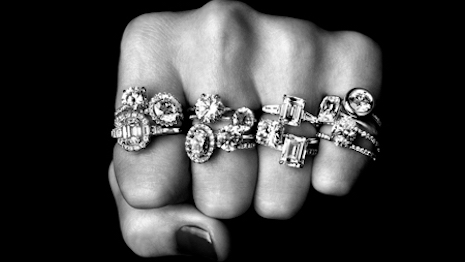Lab-grown diamonds have been gaining popularity in recent years among those who prefer a more affordable alternative to mined diamonds, but new research shows that many consumers recognize the inherent differences between the two and do not treat them as interchangeable.
The Diamond Producers Association, along with The Harris Poll, surveyed American consumers on their impressions of lab-grown and mined diamonds, in particular whether they believed them to be identical and if lab-grown stones were as authentic as the real thing. Nearly 70 percent of consumers believe that lab-grown diamonds are not “real,” lacking the natural authenticity of diamonds taken from a mine.
This runs contrary to other recent research, which has shown that consumers, particularly millennials, show significant interest in the potential of lab-grown diamonds (see story).
The main concern that consumers seem to have is with sustainability and ethics. While proponents of lab-grown diamonds purport that the synthetic alternative is less wasteful and eliminates the issue of conflict diamonds, the DPA has pushed back against this idea, countering that mined diamonds have made large strides to become more sustainable and ethical.
“Diamonds are billion-year-old treasures of the Earth that came to us very, very slowly, which makes them uniquely meaningful in today’s on-demand world,” said Jean-Marc Lieberherr, CEO of the DPA. “At a time when everything ‘artificial’ aims to compete with, and replace, ‘natural’ and ‘real,’ these results show consumers care about the inherent value, authenticity and symbolism that a diamond carries.”
In this Q&A, Mr. Lieberherr speaks in greater detail about the differences between lab-grown and mined diamonds, public perception between the two and his view on why mined diamonds are superior.
What is the difference between a laboratory-grown diamond and a natural diamond?
A natural diamond is 1 to 3 billion years old, and can take millions of years to form. A laboratory grown (also known as a synthetic) diamond is effectively an industrial replica of a real diamond. It is produced and reproduced in a few weeks in a factory, and has no inherent emotional or monetary value.
In practice, they have very different growth structures and their imperfections are of a different nature. The accelerated, industrial growth process of a synthetic diamond leaves very recognizable marks in the stone, which are visible when using professional equipment.
Equally, synthetic diamonds’ imperfections, or inclusions, are rejects from the production process. In the case of a natural diamond, natural inclusions often contain perfectly preserved elements with significant value to scientists who study the formation of the Earth.
What are some common misconceptions regarding the two?
The main misconception is that they are identical. But, in addition to the physical marks indicating the difference, consumers increasingly view natural and synthetic diamonds as entirely different products.
This is demonstrated by their respective prices. In the past year, studies show that the price differential between 1.0-carat natural diamonds and 1.0-carat synthetic diamonds has grown by 71 percent. Synthetic rubies and sapphires sell at about 10 percent of the price of natural stones. We are heading in the same direction with synthetic diamonds.

The DPA asserts that mined diamonds are completely sustainable. Image credit: Diamond Foundry
Another misconception is that synthetic diamonds are more eco-friendly. Claims of synthetic diamond producers that their products are eco-friendly are unsubstantiated and are currently being challenged. Most synthetic operations, especially in China, involve large quantities of fossil fuels.
The reality is that large mining companies, which operate sustainable operations, in very close partnership with local governments and communities, mine the vast majority of diamonds. Diamond mining involves no chemicals – and all large mining companies have policies and programs to preserve natural resources, minimize their carbon footprint, conserve land and protect biodiversity.
Finally, the diamond industry has made significant progress in the past 15 years and continues to work toward even greater levels of transparency. Conflict diamonds are largely a thing of the past and the diamond sector today supports approximately 10 million people worldwide. Diamonds are an engine for job creation and economic growth in some the most disadvantaged regions of the world.
Can the average person tell the difference between the two? If not, does it really matter to consumers?
Yes, synthetic diamonds can be distinguished easily with proper equipment. Moreover, it matters a great deal to consumers whether they are getting the real thing, inherently precious and valuable, or an industrial replica.
The DPA's #RealisRare campaign
Besides the difference in monetary value (including resale), consumers greatly value the natural origin of the stones. According to a new survey conducted by The Harris Poll, nearly seven in 10 American consumers believe that diamonds created in a factory are not “real diamonds” because they are “not naturally occurring.” Authenticity and naturalness matter to today’s consumers.
Diamonds have been a symbol of love and commitment for hundreds of years. That heritage, that preciousness, that emotion, cannot be replicated by technicians in a factory.
What do you think is the future of natural diamonds if laboratory-grown diamonds continue to get more popular?
To be sure, global consumer demand for diamond jewelry hit a new all-time high last year, climbing to $82 billion, according to industry insight data published recently by De Beers Group. Indeed, natural diamonds are appreciating as they become increasingly rare.
Meanwhile, a study from Morgan Stanley shows that synthetic diamonds account for less than 1 percent of the global diamond market. Similarly, the price and value of laboratory-grown diamonds are declining, and will likely continue to do so as production increases.
Consumers are becoming more aware of the differences between synthetic diamonds and real diamonds. They value natural diamonds for their inherent value and their emotional symbolism, which makes them irreplaceable when it comes to fine jewelry and celebrating life’s most important moments.
Consumers seem to value synthetic diamonds for their low price, which makes them attractive for fashion jewelry and accessories.
{"ct":"TIZJm84MMCSyrFJGs8QxuIrT833XvWrU6jl\/b+NJhgKpuOYM9Jr7UJvnUdNF2g8mxbDEYQ6veqmlLl5EIWfo\/+KlRN5kWKuqMnz1zz+ztbZxUD7Xl0GGr73MGPIPyWulrEpgT3BNfslCDXdl\/es9l9PhbY7Cev+N\/HfFWp0IwBYS3OtJ+n\/idEbb8J0LkhRTX4W78qyGMSmrzG4pbskUZU81NR2mv7MEBgI8kajFLV2V10Bp2FlEBmbJIg3pbEEEuOwirf+I1Uy4uWIItWicEQfy8z9JNIGFSUFSJZAEYRh2gVd8XxsGMz+7HKYTdmpzkL40fpvjf8Ew9Nw08RSRYTotIt7\/+bQ3oVy2k7WSEj2SKi4gtCzwD672Nt+7DVd9jHXiTa5KUTGrnsHxPF+RqTITzVelKF5OVXk7eJ3lejVOJfM\/jt4+LNYaVbG8CHu6EaQNjd\/vRijWVNjtCuU18It93oFvP\/dJuRbuy8HOOIPchfVTsrgTvNoVM0d3H4d+75jiZCpU5yeSg7ZZbp5ULCXub2Wz6A1wIDRDa2nIM59xmbhacB7Cx9x9lAAfQqhutcPDz9NSL32k4H4EkYvUgHnHPjq4sxmx9K0w0TjMAxQNlahVg1e+Q+KnTGHFktXYLal0sPXU\/\/rRVttR6ZVd10yPvt8sQfkaTkS\/uNt\/sUXe5cqoBlvfEglcFTPFtp4P0vKmUJcwzxsSHzFv9URkozduGpSt\/tLT++pxdeXNQAVT+EPckp9CkTD+fOnC4SFbVjiAkLRBHxRRcDfJuYXAKlCUfjMSm2IzW6DPAyDTfj5H1V1fzBjamWqgIIO2WEU0IqV39K9mwegnjD18vWIsZlP2yyllw+AY0smMCJ5+\/WtSpctb5H68z1ZSQPRPeC7U4juOVcRO\/vcOqX89h\/rk2U6u028DWEUWl9t5P+h9jME4s8wi\/yibLOe8\/E4yJUPmtMBDY4MlAo6xln05Ya6kW9nwr9iLvipwgFFWVGTEwcOsyNnDPMYKPJJUtJARcEOEWli6FlhmEHLfTFBK3twSU4bcVheprpMvLECWxDkju6K6OR75vz42H0wZ6HvD+daSkc5isYl\/h\/nb2J+Y8rCUVL3+GLeIgyJJIzZ9xEHQ+oqxAznKGEjjjn6Zrflh5fNlaRIMgxxtfFXnt1rVikqEmm6bqwgBojGL8mh2Tm\/xfQNu66Hgx6RvPfmJobQnIsLX\/45PZhGc5OalGlEeJ5UmUs59HdKj8y0Fb6b\/qiL9J93b8Jj91SQnm84kRT8ba9B9KYQpjo7BVpntBrr+4rzpEnEddelHalCeWQN6pDDQLd6hWWwYl+0cieQE5HhBntFKThDNFHaJTOswk1zMJX\/CQy\/bGiVQ\/ElCRCV4brz1zX3LAfIDFPahz4qHhuv9w\/T57qayP6Yt9muo8NWeHgjCYls73yQ9X\/m8o9DMOvlGAX5gZIm1sTWlbeta5gvFe\/jxsVXCVURfZkuW2lMhWDVfRV8ctuANNwL7Z4elXpdTR1yCfc233tgwbZYnXIoUEOXFhcKbMlYhvPluQ\/33LZscQlHcqXdfhMX6F3I5oKJZXo5xPl0zf7w4ZN5WA1cCofFpJTJ+No4XiO6L+Ny\/Kcr5Md29qmW7b4jo1HmmtISpGxEQeUaydts9icZ3ASZ8jVc4NPHITlxKswwUKaix2HPU6jioobjI51rgUmzZ+lK8N9ToauXXLRVH6q38HAW+sxCWxwvA05jpv0sr88AsICS0ce6N25wZcpkW\/AAtePfpslIkM5iUXQUEZC1Byf56aqm9Vu8CUhKDLCvFT\/J39s1aVD2SVtdA1FsxzpgshvBrksh4B4cGV2yf+rrhCn0zf+kpaGRByjyBWy6YwKfqJS\/aBxAZs8LB4hR2QQMD1yGhQqbV51TMKULHOonNdEXALiPLg4EGM9r1Gz3Kul9sSjl6VVBfj7dzCMvUKOaYErE6X1M7JlwjATXu6OpIX\/os1OMcEdGdHiinwdugA5sfMoYEcDZ+pO+ATa6K9CDXcA7nZfIjSigTc2XrWvsA2h+DQ8+dQjKUp\/ZchTM\/NKJIK0N3dKKAfN1qiusolVbGq45KPZfwWln\/oAwYcWN0MHaZV4LDnys47pxPPGPTSQlRF4G\/uSltjZfUgnKx6fr5XKLFZQqxi9udvJIIfJImN8DjR4fkJwYuBu6tQcVSL1k1rDsFHYsByN2NNLgemw\/qOYh8euDFfroDcy\/\/2OLnCT35dkmlwy6\/+0giNjs6QTCAl7igfloni95vdou6HaMJQqsIR7u2cSSf0ZJP\/ohqrHpQ2JSGE2wGLos12kcj+stpLoUioEVpdzCRj6+zBxK7b3okHl2PlWLgIPYzAcv2Xqxqe6GW9ZO\/xpNihNdVpaDfMQ2JTEzeuoTwsxvUupAJJSy86oLWJpN94B3SD3XjPGNHYbe+jg4xfmqRL9ArHI5KapwzN9+ooOaDUD6KrtvftE\/XX8+xD0oadr8qKg0v+E9hHPWc7VkNRknQuM0tXQGQugVdOHC2hr8ce0\/Bk27TdwJoM39kHJB+dbPDtXHhG60vK5PcOtQIRTrdpAkBkTHuAVOdrvjb5bMxsjT8m6WF4jeW79x2BT8K64VJD86ROq1K0Q07jyzZKyouET5VhVYc\/WwcPVlNKozFAJ+6wZzaBEO\/+3zHHCNy\/SJ3eBcdc2dwwIRUHcWw27SEJE1xRM17tobh3vE\/1+tebzUqf6tLenpr114Fj5eRJWZLEeZAeurTEpqF9ypL6VPq7nTntQLNEa30CVCQRYkRh6s6foVQYmGwnslMISBcz3kVw+CF1d3e7oRBcwS0FLFcG2\/PWsOjOe6cMRSsKeuNeXAppTBZx51yO\/FK2YpLyprfXUsz83e6yc\/4NpoRYu8orGNtw7fh8vQcZdcMq6ozHUmyRUgPt0BCRV4lAi3cQdJi27QEugkER65cXZlSy3y8QSFuHTeOiAkCfJidhTGrfabdHyOsRwrZaaOvRfid\/8azwfnuhR5IHt\/LO0Nf7rTvB7nmqPb778YQJ7zQ\/W3yS+NdfuALBSK8uJFDieyhs3TvYRkrHctaWnvVzhcON7eAQudtByaA0fp773YbxGAOnJUOErBYUzwVRIn65KkcY1Yex8IIMHvmOf2sjDRoPGhGG\/LIDmxWrt9oCmRijNE7qsSaYy0yYf6wNUcdpwzXdm8W6UD7\/mvT08u39uGocgThrInP7UzM7Pj5ZfNKi8URPFo9ZFDrwethedjD8Wna4NOFsMxRlpJtVPVY9ciZuTgFbZJ2MnkuKXR2Hw3gQiIHBYtOr5745\/F2fqrOiMer\/TQeY8UG1aKvqEYlj5F83AVbywhz5+Y8U+y+7c2apDvov6ACDaHqCzmSu3odiApjQhs3bAkpqedx1ElS24bSpJfxCSdgQ3jTeaBSLiEhTcdKLZJKIddvOaYkjiFUX7f9KKmCAm9zenvdJRAndXOJyFUTWmthDw7vgV7J5kvaKjLE0a9fua63tL\/R1iemK0ZZGggXGvM1ZMc2pUbAbIBrJstxARyGiKTrVngjrUqI7ZxB79DsmguMu6DMHW\/bW430bqbTwgUEbeK\/PdKx1oIK+UmOa018C9Q0hS5LpKbs+Y1wddK8vsGAloLotC3w7S2YCwSDA7BhxfASCmFs0MjZPFQFrhH0y9xv8AjuBXikdrhYlWGVN1xI7Fr91X+6mHWJCKL3BivHNyKjhwQOCsfpblwItwpdsaFLFo8YkNSKg\/7MUV8xDnhF7K0y6WFOs6Ux+TICPaQTMrv0SU1WT2FMq1QHrwwul782nZ9qcuq52PDmsciJpOM1sgjzH38zXs\/BvvgBBddRjcgrUDxIDdiJ\/2MNKorlBT1880LCBSpjRqjVdaNzsja8d\/G8lySBTcL78Y1fBpoZO4dv9UaphzX2afyZ5KcglucpGQKV6r34pPgUuEAzUdIOoBIeDwYjpXwRpSqnyh7Lk\/XiRqE12npYFmPD5OpIzefvSWb6I9GjpnQiW7Bj52N0mHLzqoLAAXPHGuhKJc0de9zmNZTDciHOZWFoc1pUepFRJiHd2+oaa6r9wI+NyIPL+H8A6dR5vd1pAH8cPg7n2ZfIXOqwsZ1hACfiQsj4By6leGsm6LHA5c9LlrTB5KZav0xqFKalutSg4iuUnWD\/pUPLgJYDkOj9FzgNI5UWwE7RDHiw\/ZGUBkdmel6Zyo3lItGRL3Rmn6kuIxRMbyZNfgwmVrI3hyHcrbxndqqVRbEAVz9lxgdRN6mmllGIYXZuWl8ejp7d5vFgodi9GO9mQKW0fCWZhIYYHa+Pis11W\/IFNa4psGtpHxJPr9petlbnGWSZE9o0MbGrlRDNpIZBQmqCIGOewpuz3slpWccu0rsT2zfeC4PfDX8jQetNNHDoMs\/ibwzOFiEQrrc8v9zYUY7hn6KBcP2G+Fz1OQ3C4ZLGL2cKKMB97qMLNQbWjxGVRRVf6Wq4heF2ntJpTWjpumjDZ1YJe8BizO5XYOl4GojriQl4rC\/Aq8E6w0cmmNhnaU7m2iNHpzievlF1VG+F4pK2rOOYlG+dKJsEtxkgItJ\/5X1hbjxJfczivokqE4tSQveBINfTAMdyTo2r0Mi3Z4fXu0kpFE+SxnoPb3oxV5hfNmXE2GfTlMLfWymII5OB9enh8IZvk7BBgF8hnWye0POoXUF3Urply0fAasajKinE9+LIAWOQjDQDTcNwX2VlnJlGQMqA0Qm2UG9qhuzDsygVDHoi3whOwTJjBLgz1dMPB2Io\/qSiv4T94OcJlc2ybBRqyHyQwQsOxzptA+CsSyTvRtR8QhdvxpV8+Qa6iSAOM14\/v28U547djYKB7JY2v0t5MnYFVOSm54BbLrJetQO7y+TS\/itMnbu7S8ymSvipJuE2PCRpkqT1oVQ8eXw02Hz8VUEjkGLLFTWun\/Rf3b7Q4qKjel33PvYW2f+P0hNmv9gEAefGSBokxVkp2sUZnqlasTgbPewX9iCd7pEqOYr130Uo45BxFKX1FkcuyNtw0H9F6Zo2dhXuhRURn2tIxSKfX4IRkMA3fVSboHXRdRoK+\/a1CinGSc+FvLItd7YPFY3vTrEfx9WEOhf1gOvxI7\/P2wrnJjWJjIC9w8Dg9Snt19lSabOQDzhvxPx6ED8ot8xUQpOrrd6bO20U48B7tB\/ZjWgQXKLkinxJGmTtACCq8GN5DZ19\/r\/jOikXW9DqV5eClGTnwI3W3uYy1gaMbA+iWhLUWeASJpqjNQX5gwgCJweV4T1pTc6pU\/rR0K6LkE7fUdgaSiZbIkzUT1VrUuY9\/+iRicBOk2kHjnDHQWvNb8bso5eEd8QiVBDau8BIWBAb5xmMNPjYFRs6IqYQLkK7sVB3LIkIMBehpUDxyv7uO0ZsgQE5tI46cDVj\/0oxoa8gkYe6bSnSrnl4zarQfqqJpftPtNQ\/yl4LxP0ab2ayH2WNFCzGLLD21o+mBK6atXxE8JcLsZTymObsIon4iOZ0e+S4XNJzxof63qLIGfW7WHsN3tsA4NNhTkelhKQJLmXy9yBGGrvPV2I\/XVxsi0fgZz3hkHemrq\/zkG1R\/7LrLyuZ22A9\/jHz9EgpzEXRW+J29Oz9GQ+1MlM1nX0iQ+TKNGcqP7jcbpFhQrCby9KPgTtt9bY5gqrPklQWG+NRLTCT3qoOD1rQGxIsH+ftEXzPh8t2\/DrE+9Qoyl1XunH0ZGXG+oVzuRr32m7h8wkljL2fvUZQsCO6JuKjAKBrCAmxlj1BthYJdrSR2A\/ByBmfoGgSrGuAGluYLhhTVuonYI8qc+s43erE1XMZgsYf7da3ge+RFakqOmm\/wxZizkZ51RCm4WpkqoEvPHGwDE\/tElA4AAFzLl\/gghuLW5Y77HFZn4ZVcgXgNtj9QkeINofilNxDlsHFQOgJ6y7WKlo76AsZ2FLw\/v6ttHcuG4uzptTzaYZXHoCs0UIW5oNMRl+f4naXyjk2rHIbTqkKEmlAK0TaNuVtnYmZbuVdEb47xJglzHkLnlv9\/8BN0Ys5KTMIOkpb\/dAfV+X6sx80+fu9daQTTbGxaj0oFlKG55Us4H8Dy71LNe6UUktYH\/inJwPZ0vszvTmEtNK+yRrb1RFuK6eGEUsXR9WUDQxDI3XkynIMM113xtQ8cnlXmYKr+EA7zlVNI2w+laJA4a9MiUglybRs8H0Cwisgrdof35W3nqkHrV4xS51c1VmMkJoA3AbhOKQKINFfT+P6P2HpFDXZW6NxdxzgWvSgetht2BuYlJHyPlJtyRyGnKqLKyOLSlIIYMkkIC6x9HBB9KlBDIUZFcZoZHA41QTzT9fChUAwTMHxlgeDsaZjhKhoWPKtC9NukeSdghS6y9Sqw49YetK+PuZjq6EdkfyZN1rE0i+rEG7ZV3XsROgD\/eF\/vhLviZXuJGgi2rcnHlWUT\/Pql6z03UL0Rctk+j6EZRcQXbj5SeXpRaw2kcwXgCLmdMTQXLjVEA1+jmvsaSDth1+YlXMyrClsgwWZP19QzSJVAyOaWXUsBIAPfivb58jKB3qS9ObmSiZ6bVAtBMbpOGOO1oL0CoCxR6kRUf0zfBQp5vQIzQnFEsDzWVXspjXw2HDlNz38frIR2EL8FgBwcfy4ULnOhhBXcrEAv+KKUW9m\/2FyQsiDZppI+3v\/Utfg03i4ZhgXTmr7o0VibpOrnnm+l4Nq31d9TCayz4u8IdBwHkJmiWUBMrF1zz4sGgpOHV6\/mXvrF3sdhiAVRriu\/Dsalgw7W7VdWdtA5wtL6wWbEfyOifuErNRXAIehOfhtDRk2Np\/4qAnncNbjnmJcjz8EWXM0Nv0GWwrBVSSYHo6rTyjH9eDg0acnwsE5h+tsbsHZZcu7cIjen2ZyKMHVDk\/Eep6KCFaKZtUSbgHyqqgEkAhbDNHyoiYiKMEqqLyHfSREm4y54bTjF6eBpjTsB2l75IJmd0i52Ml1tXs+j\/SQwYGTvnkHPWtJxYBNit8liTrHFABLTo8s+VizUEMPIMYa1RLgrEqlkQXSGAkSjNBCYgWRt37hN9ZVS\/\/7ptKWEhmS203Rw5FCNhV3e8qvkNnsc4LYU0HsKuRjULNBvLHcd3uZE7xtjyGIob5+yaDWubO9B6U4y6leYDBcFACr39sAg+Ib7Tetti8fNEgi9uPSOxK1JxBfBOIrf3nC+SjWKTJwaHacsVubIMGTjUJoJetZE95cWR9C1MwacbWmNDoFwgAu1kNI8gFMJPRKGyVJtP2cIr1spoWqzIBjE3+zy0CUCQMkWmYNXNRhdusmeLuvkj8xIgB8F\/w2TlQxJTAIUsBjYt\/qWYa82YM5jOrwY0N5W0XYU0owjJuundxRVnZsNtUojkmFPBwqmRxaM92LmwYpdbm3ac6zw94OfJxyflDjhDvYNN+D6Emk4KHbM7D6AN8eFJ06rAZ3Frg\/tQel19CDmEnxzIUxNwdGt7z2AeTty0\/AYlqcRCPJST6LqFPNdCwfpWw1t+21M\/pTHkp3o\/DnhUmFO59ehR0Dz4+VAlgKne68yGEjRErrzyCruN5s7ZTI7L\/zTCvh+Wt0T61UUGng4npLdidZULudf6VFy6+pOHRJrzRftqsJXhULoWLI8p2xWS5QWSxYw6Fxl1DZkpdr8GlKUBNTCEmNCkCXIh4yu0OGt8pkqEB2Vy4d5x7G4Eu3qYF+XwirfamQ1Nc1yw3Ie9x35vgu0qyp0cCPGmwXr8sWSLsTNsrRCSS9aGFux\/v6wzVVAMW7jACiH2Ok9MsISRTaJcHsTwRsE3qaKJila7UnXmoCFwLu1IwYIs5VYi7O0GKUMBnX74hcA5ux6GI3DL\/vgjHjQg2NPiZzTNax\/FnxRyVxXc6iM9ZTb0sUcIya6sjL6yBeUjipRchxa\/knmR2TQfSZHtYijazUs7R1\/fb7VXLEVgj+VPA\/CFke4aOaGkyYxK2rmz3uBKoLr3rV\/uZObgAHaeiGGzDRv30NoX\/64btYLaZev0xmZtjT88fXB7govT+cMqLTYqWhsP3aVXG\/02CtbnaFFbOdqelagBQ3ca1HLu8E9nh91QdawMkGO4SgkkeRLzl6bLUGqpd9iaZaoqSp2X15NoGrKIJOCxSdDUxJwOrF2G8mJ1iFGLNrc9qF+MgXMOed9VJ\/5s00gZe1lEhjAwp69UcrSYJiNkVpaD5FEkvlmHzYo41\/9y2rcEMj3v2U3n5rGr4oFHpjjyI+r4o2b+0LUVjw+Ze8oIF8Wz809PeA9DAl02FhHbT4Q0tPKMJ\/B2l1+7NY4mxhSVUZ\/BrORb3TJjiDbXWKp8CPWU2iqjN8YUj0HStoYRdjA6RCIofGDiY8nyJA4b+NpsVfgzEXOkVsFHFcLxyiFhvZOKCUVpM+mc8WYVzKdwDw+6RrdeIdU\/y0GAvlIEtM4k51ED0TwkAQ5Pw3IDfgIwaTHDIg6wtY8xIzOM8QGnBuw\/5aNyiP5+9OQz3Cfk4CjzBSxuvIB7J1qoM6bqnogfhf7GqzU1bngN6XGvdkJkb4vG+xPT8\/Fbvf3AJ35Q5zfGJsiry9umdQzZsXVJvZ6T2wx0gggsR1EHPrp5uUEMC\/pUju4\/KOqhPP\/SExCTjVRkxiMG72ItsEKfTHA\/CV87IssVhV6wYtcPJmu9nDo10ANsNrfrhnGgwmbJdQTY4CHhVvJ\/g85q3qMuPx\/Fsots+hE3svf3BbuultsqI5jUePDni6He6BP7TNuJGXxdMNN0dKxoAJVzoUu7YPRFFeOZJHGl22yMrHYzhHX6+6kq7d6LgJkppC3VIT+Sv33BeoPuKh3EmlLhbcOFUofhXkS3sNBuH5+51Y2zqzazqzHe9\/u3o8MJp6as\/cnnDaax4kvdL0yisO\/tLGHReVAb7nUP7R96qV\/TQQv83B0+9J3VZBySmpMCpL9uD5IsNIrGpE8cEHgeNJB6S8kwyY3X7mrw0udxvllu2HIoebk+3NueBDqYL76dd3VTjtImPITqExvF2zJYAgtyh3t9IaupZoGRqrb8ENCIGnnfKjSyzalE4Hunme4oWxLAYVsYO6bU8r98kzaWjq\/hVpUDGjPMw3+bX4f+kqNUd4mhBheIP2jpf0sLoJuvXQQm0CUB8b2bK564tDBays5NGUx0IUTBO+A6SvLsOCVfXiJ8R7yAgNG7OdcJxt6AQIRr2m8VV63cqYQmYKXIouiG4jhsw0UpptkoHg+3p+9suZMXui8D5\/uU9foAEqVtgnJNwOXcqAM1GC\/ApYxxnZtcJjWNJFblF43xFMZXD4vJhmOt7gWc6Sik3NY287j73VIRYJPwBXX1VYP5QAVfMJQXsKFmce4DY5th+yK0IBueF8vJwnvGM4qaD8OhXZ7EM0KG6G6zV9jKshRbFaEvTCZi3G6GM9uZCqD81tbYA+igqwS6xXLcbAQAjKad1gDJb+6ZtysPF1bdvtC8DoTC5oKsF7TYRB\/2CqPTruj97FJjr2BHUQ0q\/9Jiy0qY4E+sUhh\/QtSjVPg5AT3H8MtyQt2krlfE3csai1RxFTKdad7RnxQClaF8m59TKApwmQlOfqwfGxPqKtmuaU6\/I+0lKa9U+2BDmSuEt1E5HKenILXH8XXnykrltRAUtvH7nloQPspEkpQZfyyKt69InjHNuIxWHRMBaiU3tTABO+8eC3mcBRkJDumih5Nyp38Nz7Mquz\/3QqOjo9bWwYt9RrjSc9qwpFNxVFI+QGlGWa4bUUMryVloyrKIXgfv3eX3L4CYLM6F2EJXxFoi7G3yNhiwM6Ub6SyIA0Uqkbv5PIpoQNSFxPlFL+9s97LzSTVnzi2AQOO7Vn1zqHROavew7WDrZqXFPzvaUFCYTMrjGR\/KYwzyuQo36nlmHVPXUssR75S4ZxY9wIrFExRCTMpa7roa6\/hhRfMGpGQDJWk40pA9sgiXL+\/HWkGAxmq+7PnPvIXXJhEPicD1M9945xXsOwIXAHKDSth9KVs+eSTVKqChSD5vnHnaPo\/plmXf9rikliPlVWOuW6ocWC6wcqhuLPVsRPtQnmaC8mvEZt0fKotnr1\/0ZG4SNWxv8aOIY6ZMkYDuXn8bg6odWCGcIFDcuSe\/xQM1ktLw4H+6w7N6t+Uw7GM2uIWOunjaGEeLz3+hkpJhzI21RjL4zg8KttS2GCSajHKuJerftHJ9BwSxMi5avWw4y1uT\/pGywiEGJhoQsanrouYvdSSd764mqwzAHDI8RqrQAL\/OLKS2IT8UEIUyY31tecSTR38XyR85j568zVaSc=","iv":"a3b590bf0946d806cc0eeab29cf463a7","s":"cde376ea0eeace05"}

 Producers of natural diamonds push back against the idea that synthetic diamonds are indistinguishable from the real thing. Image credit: DPA
Producers of natural diamonds push back against the idea that synthetic diamonds are indistinguishable from the real thing. Image credit: DPA